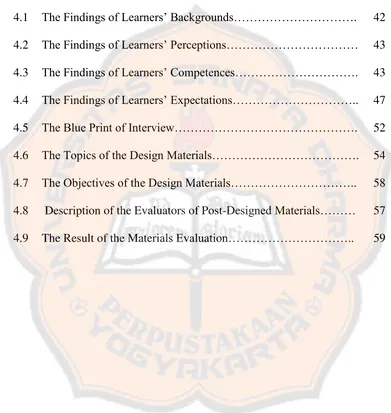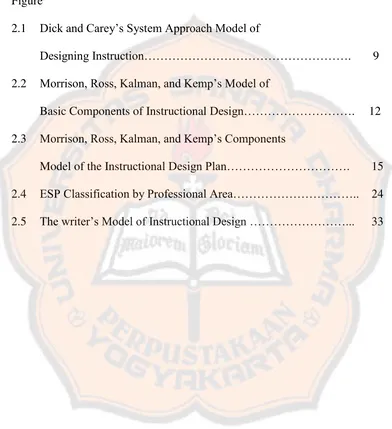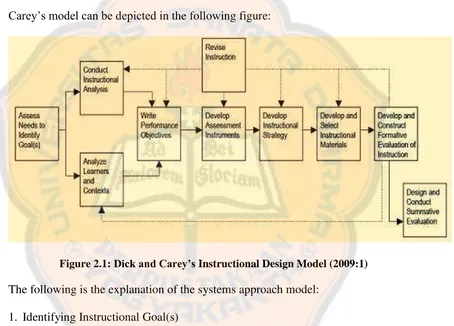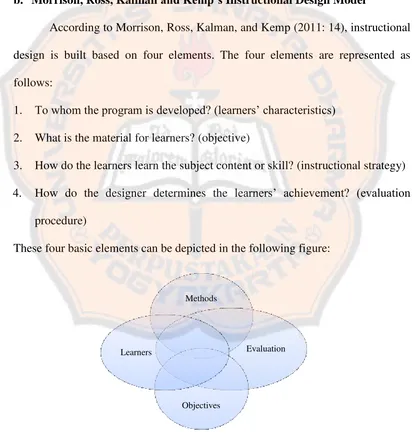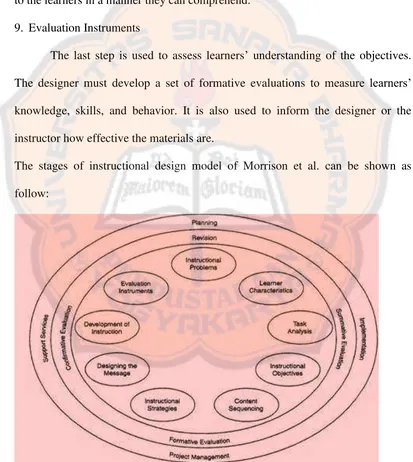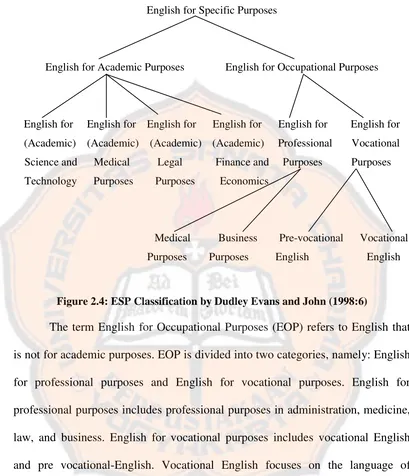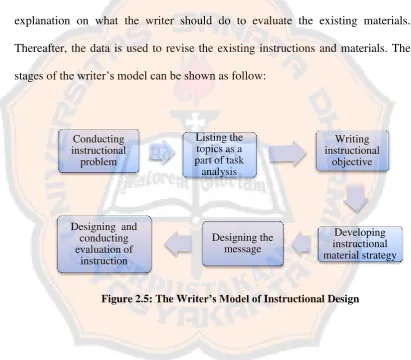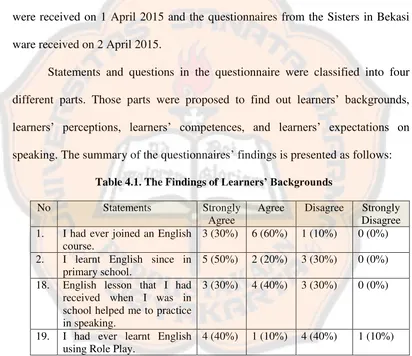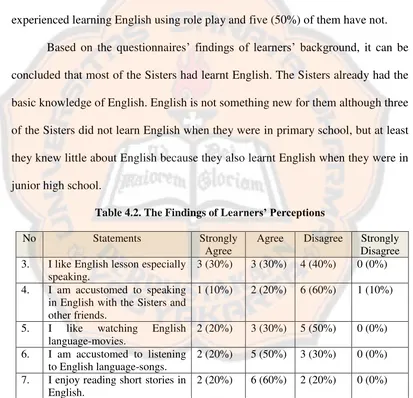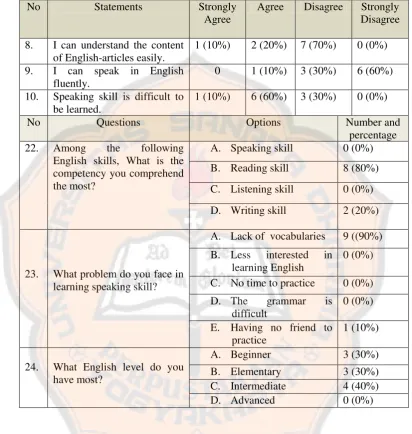i ABSTRACT
Manik, R. 2015. Designing a Set of Instructional English Speaking Materials for the Junior Sisters of Kasih Yesus dan Maria Congregation. Yogyakarta: English Language Education Study Program, Sanata Dharma University.
Kongregasi Kasih Yesus dan Maria (KYM) is one of the Diocesan Congregations located in Pematang Siantar, North Sumatra. One of the missions of the KYM Congregation is to create a peaceful world for others through charity works both domestically and internationally. Being able to work in the mission areas either in Indonesia or abroad, KYM Sisters are encouraged to learn English in order to be able to communicate in international contexts. However, most of the KYM Sisters do not have command of English. Therefore, the designed materials are proposed to fulfill the KYM Congregation’s needs in learning speaking.
The study is addressed to a question, namely “What does a set of instructional English speaking materials for the Junior Sisters of Kasih Yesus dan Maria Congregation look like?” To answer the research question, the writer used a survey study. In the survey study, the writer used questionnaires and an interview as the instruments to gather the data needed from the participants.
In order to answer the problem, the writer adapted and combined the instructional design model from Dick and Carey (2009) and Morrison, Ross, Kalman, and Kemp (2011) into six stages. Those stages were: (1) conducting the instructional problem, (2) listing the topics, (3) writing the objectives, (4) developing the instructional materials strategy, (5) designing the message, (6) designing and conducting the formative of instruction.
The designed materials as a whole consist of four units, namely (1) introducing self, (2) asking for and offering help, (3) promoting KYM Congregation, (4) visiting sick people. Each unit consisted of five elements. They were: warming-up activity, language practice, language in use, exercises, and vocabulary log. Based on the result of post-designed questionnaire distributed to the evaluators, it was found that the designed materials were acceptable to be used for the Junior Sisters of KYM Congregation.
ii ABSTRAK
Manik, R. 2015. Designing a Set of Instructional English Speaking Materials for the Junior Sisters of Kasih Yesus dan Maria Congregation. Yogyakarta: English Language Education Study Program, Sanata Dharma University.
Kongregasi Kasih Yesus dan Maria adalah salah satu kongregasi berkomunikasi dalam bahasa Inggris dalam konteks internasional. Akan tetapi, kebanyakan dari para Suster KYM tidak memiliki kemampuan berbicara Bahasa Inggris dengan baik. Karenanya, materi yang dirancang ini ditawarkan untuk memenuhi kebutuhan Kongregasi KYM dalam belajar Bahasa Inggris
Rumusan pertanyaan dalam penelitian ini yaitu: “Seperti apakah bentuk dari satu set materi pembelajaran Bahasa Inggris bagi para Suster Junior di Kongregasi KYM?” Untuk menjawab pertanyaan ini, penulis melakukan studi lapangan. Dalam studi lapangan tersebut penulis menggunakan kuesioner dan wawancara sebagai alat untuk mengumpulkan data dari para Suster dan para evaluator.
Untuk menjawab permasalahan ini, penulis mengadopsi dan menggabungkan model perancangan materi oleh Dick and Carey (2009) dan Morrison, Ross, kalman, dan Kemp (2011) kedalam enam langkah. Keenam langkah tersebut adalah: (1) melakukan analisa masalah, (2) menyususn topik, (3) menuliskan tujuan pembelajaran, (4) mengembangkan strategi pembelajaran, (5) merancang pembelajaran, (6) merancang dan melakukan evaluasi materi.
Secara umum materi pembelajaran yang dirancang ini terdiri dari empat unit yaitu: (1) perkenalan diri, (2) meminta dan menawarkan bantuan, (3) mempromosikan Kongregasi KYM, (4) mengunjungi orang sakit. Masing-masing unit terdiri dari lima bagian yaitu: warming-up activity, language practice, language in use, exercises, and vocabulary log. Berdasarkan hasil kuisioner yang dibagikan kepada para evaluator, ditemukan bahwa rancangan materi ini dapat digunakan bagi para Suster Junior KYM.
DESIGNING A SET OF INSTRUCTIONAL ENGLISH
SPEAKING MATERIALS FOR THE JUNIOR SISTERS OF
KASIH YESUS DAN MARIA CONGREGATION
A SARJANA PENDIDIKAN THESIS
Presented as Partial Fulfillment of the Requirements to Obtain the Sarjana Pendidikan Degree
in English Language Education
By Rumasta Manik Student Number: 111214154
ENGLISH LANGUAGE EDUCATION STUDY PROGRAM DEPARTMENT OF LANGUAGE AND ARTS EDUCATION FACULTY OF TEACHERS TRAINING AND EDUCATION
SANATA DHARMA UNIVERSITY YOGYAKARTA
i
DESIGNING A SET OF INSTRUCTIONAL ENGLISH
SPEAKING MATERIALS FOR THE JUNIOR SISTERS OF
KASIH YESUS DAN MARIA CONGREGATION
A SARJANA PENDIDIKAN THESIS
Presented as Partial Fulfillment of the Requirements to Obtain the Sarjana Pendidikan Degree
in English Language Education
By Rumasta Manik Student Number: 111214154
ENGLISH LANGUAGE EDUCATION STUDY PROGRAM DEPARTMENT OF LANGUAGE AND ARTS EDUCATION FACULTY OF TEACHERS TRAINING AND EDUCATION
SANATA DHARMA UNIVERSITY YOGYAKARTA
iv
Pertolonganku dari Tuhan Yang
menjadikan langit dan bumi
I dedicate this thesis to my beloved KYM Sisters,
v
STATEMENT OF WORK’S ORIGINALITY
I honestly declared that this thesis, which I have written, does not contain the work or parts of the work of other people, except those cited in the quotations and the references, as a scientific paper should.
Yogyakarta, 12 October 2015 The Writer
vi
LEMBAR PERNYATAAN PERSETUJUAN
PUBLIKASI KARYA ILMIAH UNTUK KEPENTINGAN AKADEMIS
Yang bertanda tangan di bawah ini, saya mahasiswa Universitas Sanata Dharma:
Nama : Rumasta Manik
Nomor Mahasiswa : 111214154
Demi pengembangan ilmu pengetahuan saya memberikan kepada Perpustakaan Universitas Sanata Dharma karya ilmiah saya yang berjudul:
DESIGNING A SET OF INSTRUCTIONAL ENGLISH SPEAKING MATERIALS FOR THE JUNIOR SISTERS OF KASIH YESUS DAN
MARIA CONGREGATION
beserta perangkat yang diperlukan (bila ada). Dengan demikian saya memberikan kepada Perpustakaan Universitas Sanata Dharma hak untuk menyimpan, mengalihkan dalam bentuk media lain, mengelolanya dalam bentuk pangkalan data, mendistribusikan secara terbatas, dan mempublikasikanya di Internet atau media lain untuk kepentingan akademis tanpa perlu meminta ijin dari saya maupun memberikan royalti kepada saya selama tetap mencantumkan nama saya sebagai penulis.
Demikian pernyataan ini yang saya buat dengan sebenarnya.
Dibuat di Yogyakarta
Pada tanggal: 17 September 2015 Yang menyatakan
vii ABSTRACT
Manik, R. 2015. Designing a Set of Instructional English Speaking Materials for the Junior Sisters of Kasih Yesus dan Maria Congregation. Yogyakarta: English Language Education Study Program, Sanata Dharma University.
Kongregasi Kasih Yesus dan Maria (KYM) is one of the Diocesan Congregations located in Pematang Siantar, North Sumatra. One of the missions of the KYM Congregation is to create a peaceful world for others through charity works both domestically and internationally. Being able to work in the mission areas either in Indonesia or abroad, KYM Sisters are encouraged to learn English in order to be able to communicate in international contexts. However, most of the KYM Sisters do not have command of English. Therefore, the designed materials are proposed to fulfill the KYM Congregation’s needs in learning speaking.
The study is addressed to a question, namely “What does a set of instructional English speaking materials for the Junior Sisters of Kasih Yesus dan Maria Congregation look like?” To answer the research question, the writer used a survey study. In the survey study, the writer used questionnaires and an interview as the instruments to gather the data needed from the participants.
In order to answer the problem, the writer adapted and combined the instructional design model from Dick and Carey (2009) and Morrison, Ross, Kalman, and Kemp (2011) into six stages. Those stages were: (1) conducting the instructional problem, (2) listing the topics, (3) writing the objectives, (4) developing the instructional materials strategy, (5) designing the message, (6) designing and conducting the formative of instruction.
The designed materials as a whole consist of four units, namely (1) introducing self, (2) asking for and offering help, (3) promoting KYM Congregation, (4) visiting sick people. Each unit consisted of five elements. They were: warming-up activity, language practice, language in use, exercises, and vocabulary log. Based on the result of post-designed questionnaire distributed to the evaluators, it was found that the designed materials were acceptable to be used for the Junior Sisters of KYM Congregation.
viii ABSTRAK
Manik, R. 2015. Designing a Set of Instructional English Speaking Materials for the Junior Sisters of Kasih Yesus dan Maria Congregation. Yogyakarta: English Language Education Study Program, Sanata Dharma University.
Kongregasi Kasih Yesus dan Maria adalah salah satu kongregasi berkomunikasi dalam bahasa Inggris dalam konteks internasional. Akan tetapi, kebanyakan dari para Suster KYM tidak memiliki kemampuan berbicara Bahasa Inggris dengan baik. Karenanya, materi yang dirancang ini ditawarkan untuk memenuhi kebutuhan Kongregasi KYM dalam belajar Bahasa Inggris
Rumusan pertanyaan dalam penelitian ini yaitu: “Seperti apakah bentuk dari satu set materi pembelajaran Bahasa Inggris bagi para Suster Junior di Kongregasi KYM?” Untuk menjawab pertanyaan ini, penulis melakukan studi lapangan. Dalam studi lapangan tersebut penulis menggunakan kuesioner dan wawancara sebagai alat untuk mengumpulkan data dari para Suster dan para evaluator.
Untuk menjawab permasalahan ini, penulis mengadopsi dan menggabungkan model perancangan materi oleh Dick and Carey (2009) dan Morrison, Ross, kalman, dan Kemp (2011) kedalam enam langkah. Keenam langkah tersebut adalah: (1) melakukan analisa masalah, (2) menyususn topik, (3) menuliskan tujuan pembelajaran, (4) mengembangkan strategi pembelajaran, (5) merancang pembelajaran, (6) merancang dan melakukan evaluasi materi.
Secara umum materi pembelajaran yang dirancang ini terdiri dari empat unit yaitu: (1) perkenalan diri, (2) meminta dan menawarkan bantuan, (3) mempromosikan Kongregasi KYM, (4) mengunjungi orang sakit. Masing-masing unit terdiri dari lima bagian yaitu: warming-up activity, language practice, language in use, exercises, and vocabulary log. Berdasarkan hasil kuisioner yang dibagikan kepada para evaluator, ditemukan bahwa rancangan materi ini dapat digunakan bagi para Suster Junior KYM.
ix
ACKNOWLEDGEMENTS
On this occasion, I would like to dedicate my gratitude to Almighty God for the blessing and love so that I could finish my thesis. My sincere gratitude goes to my beloved thesis advisor, Christina Lhaksmita Anandari, S.Pd., Ed.M., for her kindness, advice and willingness in giving ideas, suggestions, and feedback in the process of finishing my thesis. I also wish to express my sincere thanks to Dra. Novita Dewi, M.A. (Hons), Ph.D., Mega Wulandari, S.Pd., M.Pd., and Sr. Aniceta P, KYM for their willingness to evaluate the designed materials.
Many thanks also go to all my beloved PBI lecturers that have helped and educated me to be a better person during my study in PBI. My greatest gratitude is also addressed to my academic advisor Yuseva Aryani Iswandari, S.Pd., M.Ed., for her love and support.
x
I am also grateful to my beloved KYM Sisters who had helped and gave me everything I need during my study in Yogyakarta. Next, I would like to address my gratitude to my beloved parents, my sister and brothers for the prayer, love and support. Many thanks are also addressed to all my batch mates in PBI 2011 especially to all my friends in class C. I thank them for the friendship, love, sharing, jokes, and happiness.
xi
TABLE OF CONTENTS
TITLE PAGE………...……… i
APPROVAL PAGES………... ii
STATEMENT OF WORK’S ORIGINALITY………. v
PERNYATAAN PERSETUJUAN PUBLIKASI………. vi
CHAPTER II. REVIEW OF RELATED LITERATURE…………. 8
A. Theoretical Description……… 8
1. Instructional Design Models……….. 8
a. Dick and Carey’s Instructional Design Model…………. 8
b. Morrison, Ross, Kalman, and Kemp’s model………….. 12
2. Speaking Skill………. 16
a. The Nature of Speaking……… 16
b. The Process of Speaking……….. 16
c. Teaching Speaking……….. 18
3. English for Specific Purposes……… 20
a. The nature of ESP……… 20
b. Definition of ESP……….... 21
xii
d. Classification of ESP Program………. 23
4. Task-Based Language Teaching…..……….. 25
a. The Principles of TBLT……… 25
b. Teacher Role………. 26
c. Learners Role……….... 27
d. Task and Activity Types……… 28
B. Review of Related Study………. 30
C. Theoretical Framework……… 31
CHAPTER III. RESEARCH METHODOLOGY……….. 34
A. Research Method………... 34
B. Research Setting……….. 35
C. Research Participants……… 35
D. Instruments and Data Gathering Technique………. 36
E. Data Analysis Technique………... 38
F. Research Procedure………... 39
CHAPTER IV. RESEARCH FINDINGS AND DISCUSSION…….. 41
A. The Combination of Steps in Designing a Set of Instructional Speaking Materials for the Junior KYM Sisters……….. 41
1. Conducting Instructional Problem………. 41
a. The Findings of Questionnaire……… 42
b. The Findings of Interview……… 51
2. Listing the Topics………... 54
3. Writing Instructional Objectives……… 55
4. Developing Instructional Material Strategy………... 56
5. Designing the Message ………...……….. 57
xiii
CHAPTER V. CONCLUSION AND RECOMMENDATIONS…… 63
A. Conclusion…...………. 63
B. Recommendations………. 64
REFERENCES……… 66
xiv
LIST OF TABLES
Table
4.1 The Findings of Learners’ Backgrounds………. 42
4.2 The Findings of Learners’ Perceptions……… 43
4.3 The Findings of Learners’ Competences………. 43
4.4 The Findings of Learners’ Expectations……….. 47
4.5 The Blue Print of Interview………. 52
4.6 The Topics of the Design Materials………. 54
4.7 The Objectives of the Design Materials……….. 58
4.8 Description of the Evaluators of Post-Designed Materials……… 57
4.9 The Result of the Materials Evaluation……….. 59
xv
LIST OF FIGURES
Figure
2.1 Dick and Carey’s System Approach Model of
Designing Instruction………. 9 2.2 Morrison, Ross, Kalman, and Kemp’s Model of
Basic Components of Instructional Design………. 12 2.3 Morrison, Ross, Kalman, and Kemp’s Components
xvi
LIST OF APPENDICES
Appendix 1 Instruments of Needs Analysis……….. 67
Appendix 2 Recapitulation of learners’ Questionnaire of Needs Analysis……….. 73
Appendix 3 Interview Transcript……….. …… 76
Appendix 4 Materials Evaluation Questionnaire………... 80
Appendix 5 Instructor’sGuideline………. 83
1 CHAPTER 1 INTRODUCTION
This chapter is divided into six sections, namely the research background, the problem formulation, the problem limitation, the research objectives, the research benefits, and the definition of terms. In the research background, the writer describes the topic of this study and the reason in choosing this topic. In the problem formulation section, there is a question which will be discussed in this study. The problem limitation contains the scope of this study. Furthermore, this chapter also provides the benefits of the study for the KYM Congregation and for future researchers. The last section is the definition of terms, which defines the concepts of the title which aim to avoid misunderstanding and interpretation of this study.
A. Research Background
interact with others. Through learning and mastering speaking, people are expected to be able to communicate with others. Considering the importance of speaking ability nowadays and based on the writer’s observation, the writer sees that English should be learned by the Junior Sisters of KYM Congregation.
Kongregasi Kasih Yesus dan Maria (KYM) is one of the Diocesan Congregations in Indonesia located in Pematang Siantar, North Sumatra. KYM stands for Kongregasi Kasih Yesus dan Maria Bunda Pertolongan Baik (Sisters of Charity of Jesus and Mary, Mother of Good Succor). The original name of this congregation is Zusters van Liefde van Jesus en Maria, Mooder van Goede Bijstand. The congregation was founded in Schijndel, the Netherlands on 1st November 1836 by Antonius van Erp. In Indonesia, the congregation was established on 1st April 1928 and the name of the congregation was translated and abbreviated into Indonesian as KYM.
the KYM community, KYM Sisters experience difficulties in communicating with them. They do not know how to convey what they are going to say spontaneously. They also face difficulties in reading English text books. Hence, by learning how to speak in English in the proper ways, Junior KYM Sisters are expected to be able to speak in English with others and with the local people in their work field later on when they are delegated to work abroad. Additionally, KYM Congregation does not provide any materials for speaking.
Based on the previous reasons, Junior KYM Sisters need English instruction in order to enable them to learn and to practice how to communicate well. It is important to prepare Junior KYM Sisters through language training program with a particular designed for them. In language training program, there is a program for specific needs called English for Specific Purposes (ESP). ESP is a program in which learners learn based on their needs. English for Specific Purposes is a concept of learning which the materials are designed based on learners’ needs and help learners learn specifically.
B. Research Problem
In this study, the research problem is:
1. What does a set of instructional English speaking materials for the Junior Sisters of Kasih Yesus dan Maria Congregation look like?
C. Problem Limitation
In this study, the writer only focuses on designing a set of instructional English speaking materials. The designed materials are intended to help KYM Congregation prepare Junior Sisters to speak English well. The designed materials are developed based on Junior KYM Sisters’ needs.
D. Research Objectives
The objective of this study is:
1. To present the designed a set of instructional English speaking materials for the Junior Sisters of Kasih Yesus dan Maria Congregation.
E. Research Benefits
This study aims to give benefits to: 1. KYM Congregation
language. Thus, the designed materials can be used to help Junior Sisters learn and practice speaking in English.
2. Future Researchers
This study can be used as a reference for future researchers who want to conduct a study in developing instructional English speaking materials for specific purposes.
F. Definition of Terms
In order to avoid misunderstanding and misinterpretation, in this part the writer defines the terms used in this study.
1. Instructional Design
Morrison, Ross, Kalman, and Kemp (2011) state “instructional design is a systematic design process based on what we know about learning theories, information technology, systematic analysis, educational research, and management methods” (p. 6). Based on the definition, it can be said that the instructional design is related to how designer uses the information to formulate a plan in order to connect learners with the instruction and materials. Instructional materials in this study are defined as the materials which are designed by the writer based on the Junior KYM Sisters’ needs and the materials are used to help them speak English.
2. Speaking
productive or oral skill which consists of producing systematic verbal utterances to convey meaning” (p. 48). Therefore, it is necessary to learn speaking skill in order to convey ideas to someone clearly. In this study, speaking skill means the ability of the Junior KYM Sisters to communicate in English with others or foreigners.
3. Junior Sisters of KYM Congregation
Junior KYM Sisters are the Sisters who have graduated from the novice and they are in the juniorate period. Juniorate period means the Junior Sisters are still on the temporary vows.
4. English for Specific Purposes (ESP)
English for Specific Purposes is a set of materials for learners based on learners’ needs and specific purposes. Former writer Strevens states that English for specific purposes on absolute characteristics consists of English language teaching which is designed to meet specified needs of the learner or based on particular occupations (as cited in Dudley-Evans & John, 1998, p. 3). English for Occupational as one of the branches of ESP is used as a reference in designing the materials. In this study, the term of “English for the Junior Sisters of KYM Congregation” is a part of EOP because the designed of English speaking materials used to prepare the Junior Sisters to be ready to work abroad.
5. Task-Based Language Teaching (TBLT)
8 CHAPTER II
REVIEW OF RELATED LITERATURE
This chapter discusses the review of related literature which is used to answer the question in the problem formulation. This chapter is divided into three sections. They are the theoretical description, the review of related study, and the theoretical framework. In the theoretical description, the writer discusses the basic theories of instructional design model, speaking skill, English for specific purposes, and task-based language teaching. The theories are used as references to create the framework of the design materials. In the review of related study, the writer discusses relevant research to the study that is the implementation of English for Specific Purposes. In the theoretical framework, the writer discusses the framework of the design materials used in the study briefly.
A. Theoretical Description 1. Instructional Design Model
In this study, the writer confers two kinds of instructional design models. The two models are Dick and Carey model (2009) and Morrison, Ross, Kalman, and Kemp model (2011). The brief discussions of these two instructional design models are presented as follows:
a. Dick and Carey’s Instructional Design Model
The components are identifying instructional goals, conducting instructional analysis, analyzing learners and contexts, writing performance objectives, developing assessment instruments, developing instructional strategy, developing and selecting instructional materials, designing and conducting formative evaluation of instruction, and revising instruction. The stages of the Dick and Carey’s model can be depicted in the following figure:
Figure 2.1: Dick and Carey’s Instructional Design Model (2009:1) The following is the explanation of the systems approach model:
1. Identifying Instructional Goal(s)
2. Conducting Instructional Analysis
An instructional analysis is a set of procedure to identify relevant steps for learners to reach the goal. In this step, it is important to examine each step to determine what skills and knowledge are necessary for learners. Thereafter, a designer is required to identify the major clusters of information that learners must recall.
3. Analyzing Learners and Contexts
In this step, the designer needs to search for information of learners’ characteristics such as behavior, motivation, attitude, prior knowledge, and also learners’ skills. The designer could administer questionnaire and survey to obtain information about learners’ interest, goal, attitude, and self-reported skills. This step aims to help the designer understand learners’ characteristics and adjust contexts in which learners will learn the skills and use the contexts.
4. Writing Performance Objective
The designer writes the objectives, specific statements, and detail descriptions of what learners will be able to do after they complete a unit of instruction. The objectives should begin with the behaviors that are described in the skill statements.
5. Developing Assessment Instruments
6. Developing Instructional Strategy
The strategy in this step refers to varieties of teaching and learning activities. The designer identifies the strategy that is going to be used in order to achieve the goals. The next part is to identify how the strategy is useful in engaging learners to learn. In developing instructional strategy there are five sequences that should be considered. They are indicating the formula of objective, indicating the approach used to pre-instructional activities, indicating the contents to be presented, defining media and time allocation, and reviewing the entire strategy again.
7. Developing and Selecting Instructional Materials
Instructional materials refer to media that will be used such as instructor’s guides, learners reading list, power point, and video to produce instruction. Therefore, it is important to select instructional materials that are suitable for learners. It also means that all the instructional materials should help the learners learn efficiently.
8. Designing and Conducting Formative Evaluation of Instruction
9. Revising Instruction
The last step, the designer collects the data from the formative evaluation to find out and to examine the validity of all previous steps. All the data should be synthesized and analyzed in order to locate the potential problem. Afterward, the designer revises and develops the materials revision.
b. Morrison, Ross, Kalman and Kemp’s Instructional Design Model
According to Morrison, Ross, Kalman, and Kemp (2011: 14), instructional design is built based on four elements. The four elements are represented as follows:
1. To whom the program is developed? (learners’ characteristics) 2. What is the material for learners? (objective)
3. How do the learners learn the subject content or skill? (instructional strategy) 4. How do the designer determines the learners’ achievement? (evaluation
procedure)
These four basic elements can be depicted in the following figure:
Figure 2.2: Morrison, Ross, Kalman, and Kemp’s Model of Basic Components of Instructional Design (2011:15)
Methods
Evaluation
Based on the previous four components identified, Morrison et al. (2011) develop a complete instructional design model into nine stages. The nine stages are:
1. Instructional Problem
The first step in designing process is to identify client’s needs or problem in which the client eager to solve. The designer needs to conduct a need analysis in order to identifying problem and selecting an appropriate solution. The purpose of identifying the problem is to determine whether instruction should be a part of the solution or not.
2. Learner and Contextual Analysis
This step aims to identify learners’ characteristics such as general background, age, learning style, assumption, and work experience. The designer can use observation, questionnaire, and interview to obtain data of learners’ personal and social characteristics.
3. Task Analysis
4. Instructional Objectives
In this step, the designer specifies what the learners should achieve or master after completing a unit of instruction. The objective should be grouped into cognitive, psychomotor, and affective domains. These objectives also become indicators to evaluate whether the instruction helps learners in solving the problem or not.
5. Content Sequencing
In content sequencing, information should be presented in a logical sequence. The designer should present the materials systematically. It is used to help learners catch the ideas efficiently and effectively.
6. Instructional Strategies
The goal of the instructional strategy is to design instruction so that learners are motivated to learn. This process requires the designer to create innovative ways to present the materials to the learners. Hence, the learners will integrate their idea with the materials given easily. The instructional strategy should be able to help the learners develop an understanding when studying new materials.
7. Designing the Message
8. Development of the Instruction
This part is the process to involve all the elements together in order to produce instructional materials such as print materials, web pages, and video recording. The designer must consider how to accurately convey the information to the learners in a manner they can comprehend.
9. Evaluation Instruments
The last step is used to assess learners’ understanding of the objectives. The designer must develop a set of formative evaluations to measure learners’ knowledge, skills, and behavior. It is also used to inform the designer or the instructor how effective the materials are.
The stages of instructional design model of Morrison et al. can be shown as follow:
2. Speaking Skill
In order to be able to communicate with others, certainly, speaking ability is needed. Speaking ability enables people to convey what they want to say to others. In this part, the writer discusses three basic theories of speaking skill. The basic theories are the nature of speaking, the process of speaking, and teaching speaking.
a. The Nature of Speaking
Essentially, speaking is different from writing. Hughes (2002) makes distinction about the nature of speech in contrast to writing. Spoken happens spontaneous, temporary, depending on context, oral, and dynamic. Writing happens plainly, non-temporary, visual, and static. Nunan (2003) states, “speaking is the productive oral skill” (p. 64). Speaking as an oral skill is used to convey information, ideas, and thought in interactions. Speaking can be done at least by two people; they are a speaker and a listener. In speaking activity, the speaker produces utterances and the listener should be able to understand what the speaker
says in their interaction. b. The Process of Speaking
daily conversation speak automatically and produce utterances easily. Meanwhile, the foreign language learners need to think first what they want to say and sometimes it takes a long time. Former writer Levelt states that the process of speaking is influenced by the cognitive process (as cited in Goh & Burns, 2012, p. 35). Levelt’s model explains how the cognitive of language learners produce speech in speaking performance.
Levelt’s speech production consists of three interconnected steps. The steps are conceptual preparation, formulating, and articulation. The first step is conceptual preparation. Conceptual preparation is a process where the speakers choose a subject matter or information they want to talk about. The language learners have to think first what information or response they want to say during the conversation. It happens because language learners’ ability in conveying the idea related to learners’ background and how well they know about a certain topic.
Second is formulation. According to Garman, “formulation is a process by which the idea that exist in the speaker’s mind during conceptual preparation are mapped on to specific words in the speaker’s mental lexicon and strung together”
As a result, most of the language learners are afraid to speak because they are not sure about their pronunciation. For instance, the language learners may know a particular written word in their mind but unable to articulate it because they are not sure of its pronunciation. Thus, the conceptual preparation (thinking about what to say), the formulation (how to say words), and the articulation (saying the words loudly in real conversation) are three stages that contribute to speech production in speaking process.
c. Teaching Speaking
Teaching speaking activity deals with some principles. Nunan (2003) formulates five principles of teaching speaking. The principles are:
1. Understanding between Second Language and Foreign Language Learning. The teacher needs to know about learners whether or not they are second language learners (SL) or foreign language learners (FL). Foreign language learners are those who study English in a country where the English is not used as a language of communication in society. Second language learners are those who study English in a country where the English is used for communication in the society.
2. Giving Students Practice with Both Fluency and Accuracy.
3. Providing Opportunities for Students to Talk.
The teacher creates atmosphere in which the learners will have a chance to speak more with their friends by using group work or pair work and limiting teacher talks.
4. Planning Speaking Tasks that Involve Negotiation for Meaning.
In a conversation, the learners need to check whether or not he/she understands what someone talks about. Therefore, the teacher can design tasks in form of dialogues to the learners in order to help them practice and understand the content of the conversations.
5. Designing Classroom Activities for Transactional and Interactional Speaking. Speaking is close to conversations include both of transactional and interactional purposes. Therefore, it is important for the teacher to prepare a guidance and practice in both transactional and interactional speaking. Also, the teacher needs to know what the learners’ purposes to have a conversation are.
In relation to speaking, Gebhard (1996) says, “when the purpose is transactional, the focus is primarily on the meaning of the message” (p. 169). For instance, a patient tells about her pains to a doctor. The next one, when the purpose of speaking is interactional, the focus is to keep social relations. For instance, greeting, complimenting, and chatting. However, most of the time conversations include both of interactional and transactional purposes.
learners to give short answer. The limitation aims to make conversation manageable. The second one is meant to use quasi-communication. It is used to help the learners practice using English in their conversation. Other writer, Kayi (2006) on the TESL journal proposed six activities in teaching speaking, namely group interaction, discussion, dialogue, role play, interviews, and presentation.
3. English for Specific Purposes
English for the Junior KYM Sisters in this study is a part of English for Specific Purposes (ESP) as explained in the previous chapter. In this section, the writer would like to discuss four elements of ESP program. They are the nature of ESP, the definition of ESP, the criteria of ESP, and the classification of ESP. a. The Nature of ESP
English for Specific Purposes is not a program that appears suddenly but it develops from times to times. According to Hutchinson and Waters (1987), English for Specific Purposes is not a planned or coherent movement, but it grows as times flies in some convergences trends (p. 6). There are three main reasons that influence the development of ESP program. They are the demands of a brave new world, the revolution in linguistics, and focus on the learners.
knowing the language. However, English has already become a key to the international currencies of technology and commerce.
The second is the revolution on linguistics. At the beginning, linguistics aims to describe the rules of English usage that is grammar. However, the new studies modify that language is used for a real communication. In short, English is needed by certain groups and linguistics features can be used to identify learners’ needs.
The third is focus on the learner. The development in educational psychology gives the essential contribution on the development of ESP. Based on psychology’s perspective, learners have different needs and interests in learning. This point of view becomes an inspiration for ESP to develop the program in which the program is relevant to the learners’ needs. Hence, the learners can learn faster and effectively.
b. Definition of ESP
language (grammar, lexis, and register) with the appropriate methodology. ESP as variable characteristic means ESP can be related to specific purposes, in specific teaching situations, and different methodology from that of general English. The methodology in ESP teaching means the nature of interaction between the teacher and the learners is more intensive than in a general English class. It happens because the focus in ESP is on training while in general English is on education.
Based on previous three definitions can be concluded that ESP program is a program which focuses on specific purposes; based on learners’ needs, and learners’ needs will determine the content of the materials.
c. Criteria of ESP
ESP as a program of learner-centered has some criteria. According to Robinson (1991), the criteria of ESP are:
1. ESP is a Program Goal-Directed.
Basically, learners have to learn English because they need English for their work purposes, not because they are interested in English. Hence, all the materials and learning activities should be suitable for learners’ needs.
2. ESP Program Should be Based on Needs Analysis.
3. Basically, ESP Learners are Adults than Children.
More frequently the learners of ESP program are those who are studying in a higher education. Nevertheless, ESP can be taught to the beginner learners in English.
4. Teach Learners Who Have the Same Needs in the Same Class.
In ESP class, it is important to put the learners who have the same needs in a same class. The reasons are to prepare the content of the materials based on learners’ needs specifically and to make the learning process more effectively.
Hence, English for the Junior KYM Sisters belongs to ESP. The reasons are Junior KYM Sisters learn English for their work purposes (to help them work abroad), the materials based on the Junior Sisters’ needs, and the focus is for training. Those reasons are relevant to the criteria of ESP proposed by Robinson (1991).
d. Classification of ESP Program
English for Specific Purposes
English for Academic Purposes English for Occupational Purposes
English for English for English for English for English for English for (Academic) (Academic) (Academic) (Academic) Professional Vocational Science and Medical Legal Finance and Purposes Purposes Technology Purposes Purposes Economics
Medical Business Pre-vocational Vocational Purposes Purposes English English
Figure 2.4: ESP Classification by Dudley Evans and John (1998:6)
4. Task-Based Language Teaching (TBLT)
Long (1985) states task-based language teaching is an approach in language teaching in terms of target tasks. According to Long, “target task is a piece of work undertaken for oneself or for others, freely or for some reward (as cited in Nunan, 2004, p. 2). Based on the definition, it can be said that task-based language teaching focuses on using authentic language in the classroom in which the learners will learn more based on the tasks given. In this part, the writer would like to discuss four elements of TBLT, namely the principles of task-based language teaching, teacher roles, learners roles, and activity types.
a. The Principles of Task-Based Language Teaching
Nunan (2004) summarizes seven principles of task-based language teaching. Those principles are presented as follows:
1. Scaffolding
An educator provides a supporting framework inside which the learning can take place. The educator needs to realize that at the beginning of the learning process, the learners should not be expected to produce language that has not been introduced.
2. Task Dependency
3. Recycling
In this part, recycling allows the learners to encounter target language items in a range of different environments, both linguistic and experiential. Also, the learners will see how a particular item of linguistic features used in different content area.
4. Active Learning
An active learning means the learners learn best by actively using the language they are learning. Afterward, it is important to give more opportunities for the learners to use the language.
5. Integration
The educator gives clear explanation to the learners about the relationships between linguistic form, communicative function, and semantic function.
6. Reproduction to creation
The educator designs tasks in order to give the learners mastery of form, meaning, and function. The learners should be encouraged to move from reproductive to creative language in use.
7. Reflection
The educator gives the learners opportunity or task to reflect on what they have learnt and how well they are doing.
b. Teacher Roles
for the learners. Also, the teacher must be careful in choosing tasks which mean tasks should be suited to learners’ needs, interests, and language skill levels. The second role is the teacher has to prepare the learners for tasks. In this section, the teacher can prepare pre-task for the learners. Thereafter, the learners should be assisted in learning and in remembering beneficial words or phrases to make the tasks easy to be done. The third role is the teacher as consciousness-raising. The teacher has a role to organize varied tasks. The teacher helps the learners to do the tasks given actively. Also, the teacher has to examine learners’ tasks.
c. Learners Roles
d. Task and Activity Types
Pattison (1987) proposes seven task and activity types in task-based language teaching (as cited in Nunan, 2004, p. 57). Those task and activity types are presented as follows:
1. Dialogues and role plays
The teacher can create an atmosphere in which the learners have a chance to use the target language. For instance, the learners are given clear instructions to create dialogues. The teacher can give some choices of what to say and explain clearly what the learners should do in creating the role plays. It is used to help the learners participate actively in using the target language.
2. Matching activities
In this part, the teacher provides a set of dialogue and asks the learners to complete the dialogue by matching the items provided. In matching activity, the learners can work in pairs to increase learners’ talk time in the target language. 3. Communication strategies
In this activity, the learners should be encouraged to produce ideas in a limited time. It is used to help the learners to think quickly and effectively. For example, learners are given a task to paraphrase and to invent words.
4. Pictures and picture stories
5. Puzzles and problems
There are many types of puzzles and problem. In this part, the learners are asked to make guesses, draw on their general knowledge and personal experience. For example, the learners are given a case to be solved. The learners can use their imagination and tests their powers of logical reasoning.
6. Discussion and decisions
This activity requires the learners to collect and share information to reach a decision. For example, the learners are asked to decide which items from a list are essential to have on a mountain area.
7. Questions and answers.
B.Review of Related Study
In this section, the writer discusses a relevant study related to the implementation of English for Specific Purposes in education field. The study is taken from Theory and Practical in Language Studies journal.
English for Specific Purposes had developed as a program to meet the needs of particular groups more effective than general English programs or courses. In ESP class the content of the materials are based on learners’ needs, while in general English class the materials are school centered-based. Su (2011) in that journal states that ESP course is designed to meet both communicative and linguistic needs of the students. In other words, learners’ needs become the first criteria in designing the materials. It is clearly explained that ESP is a program learners-centered where all the elements of ESP are suited with the learners as discussed in the previous theoretical description.
C.Theoretical Framework
Learning a certain language relates how to use the language for communication. In order to have an ability to communicate well in society, speaking skill is important to be developed. Therefore, the writer designs a set of instructional English speaking materials for the Junior Sisters of KYM Congregation. In designing the materials, the writer uses the theories of Instructional Design Models, Speaking Skill, English for Specific Purposes, and Task-Based Language Teaching as discussed in the theoretical description.
The theory of speaking skill is used to understand the characteristics of second language learners in speaking proses. English for specific purposes is used as guideline in designing the contents of the materials. The principles of task-based language teaching are used to create learning activities in the design materials.
The writer uses the combination of instructional design model proposed by Dick and Carey (2009) and also Morrison et al. (2011) in designing a set of instructional English speaking material for the Junior Sisters of KYM Congregation. The writer combines the two models to find out flexible and effective stages in designing the materials. The writer combines and modifies the two models into to six stages. The combination of these two models is presented as follows:
1. Conducting Instructional Problem (Morrison et al.)
chooses first step from the Morrison et al. because they suggest the writer to search first the problem of the learners. This step is relevant to the characteristics of ESP which the materials should be based on learners’ needs.
2. Listing the Topics as a Part of Task Analysis (Morrison et al.)
The second step is the writer identifies subject content for learners. This step aims to decide topics or knowledge will be taught for the learners. The writer chooses this step because Morrison et al. define clearly what the designer should do in determine a topic. Also, they suggest the designer to use a topic analysis to identify objectives, design the instructional strategies, and create instructions. 3. Writing Instructional Objective (Morrison et al.))
The next step is the writer has to write the objectives or what learners will be able to do after the learning process in a clear statement. In this step, the writer should consider cognitive, psychomotor, and affective domains. The reason in choosing this step is also to use the domain aspects as a guideline to create the content of the materials.
4. Developing Instructional Material Strategy (Dick & Carey)
This step is used to determine what kind of learning activity will be used to teach the materials. It is important in order to help learners practice during the learning process. The writer chooses this step because Dick and Carey give steps to develop instructional material strategy to teach the materials for learners.
5. Designing the Message (Morrison et al.)
provide appropriate pictures to convey messages to the learners. The role of pictures in this step is to grab learners’ attention in learning.
6. Designing and Conducting Evaluation of Instruction (Dick & Carey)
This step is aimed to develop a set of draft evaluation to collect data. The writer chooses the evaluation step from Dick and Carey because they give clear explanation on what the writer should do to evaluate the existing materials. Thereafter, the data is used to revise the existing instructions and materials. The stages of the writer’s model can be shown as follow:
Figure 2.5: The Writer’s Model of Instructional Design
34
CHAPTER III
RESEARCH METHODOLOGY
This chapter discusses how the study was conducted in terms of obtaining and analyzing the data to answer the research problem of this study. It is divided into six sections. They are the research method, the research setting, the research participants, the instruments and data gathering technique, the data analysis technique, and the research procedure. The explanation of each part is explained briefly in the following part.
A. Research Method
In order to answer the research problem of this study, the writer used a mixed method. Creswell (2003) states, “mixed method is approach focuses on collecting and analyzing both quantitative and qualitative data in a single study”
B. Research Setting
The study was conducted in Susteran KYM. It is located at jalan Merak no. 10, Papringan, Yogyakarta. The writer distributed the questionnaires to all the respondents in March. The study was conducted in a week started on 27 March unti 2 April 2015.
C. Research Participants
In this study, there were two groups of participants. They are participants of information collecting and participants of material validation. The discussions of these two groups are presented as follows:
1. Participants of Information Collecting
In order to gain a valid and a reliable data of the study, the writer selected the entire population. In this study, the writer used purposive sampling. Fraenkel, Wallen, and Hyun (2012) state, “purposive sampling is a strategy in which researcher uses their judgment to select a sample that they believe to get the data they need” (p. 100). The writer chose participants based on the writer’s point of view. The reason in using purposive sampling was to get a real and complete data. Also, the locations of the participants are reachable. Thus, if unexpected things happen the writer could easily to follow-up the data.
three Sisters from Surabaya, and four Sisters from Bekasi. The participants are between 24-32 years old.
2. Participants of Material Validation a. KYM Sister
One of the participants of material validation was a KYM Sister and she is an English teacher. The Sister gave feedback and evaluation to the designed materials.
b. Experts
The other participants of the materials validation were two experts from lecturers of English Education Study Program Sanata Dharma University. The Sister and experts would be given questionnaires and proposed the designed materials in order to evaluate the existing material.
D. Instruments and Data Gathering Technique
In this study, the writer used two kinds of instruments, namely questionnaires and an interview. The instruments were used to get information about Junior KYM Sisters’ needs, interests and characteristics. Furthermore, the writer also used post-designed questionnaires to get evaluation from the evaluators.
a. Questionnaire
information, often numerical data being able to be administered without the presence of the researcher, and often being comparatively straightforward to analyze” (as cited in Cohen, Manion, & Morrison, 2003, p. 245). In this study, the writer used two types of questionnaire. They were: closed-ended questionnaire and open-ended questionnaire.
The type of questionnaire used for participants was a close-ended questionnaire. Closed-ended questionnaire used to gain information from the participants. Closed questions are the questions which are constructed by providing some answers or choices to be chosen by the participants. The questionnaires for the participants wrote in Indonesian. The reason was to help the participants answer the questions easily. The writer provided 26 closed-questions by providing some answers or choices to be chosen by the participants. The participants just choose the best answer based on their experiences.
The types of questionnaires used for the evaluators were closed-ended questionnaire in form of Likert scales and open-ended questionnaire. A Likert scale is a type of closed-question where researcher provides a range of responses or statements to be chosen by the evaluators of the study. Open-ended question is a type of questionnaire in which the respondents have a chance to give their personal comment and researcher might have a depth response from the respondents. Thus, open-ended questions are used to get feedback, evaluation, and recommendations from the evaluators.
closed-ended questionnaire, the writer provided several statements and asked evaluators to give assessment based on the degree of the agreement scale. In open-ended questionnaire, the evaluators are allowed to give their opinions, feedback, and recommendations in the designed materials based on information in the background of the study and the proposed design.
b. Interview
The next was an interview. According to Cohen, Manion, and Morrison (2003), research interview is a conversation initiated by the interviewer for the specific purpose in order to gain relevant information (p. 269). On the other hand, an interviewer provides a set of questions to be answered by the interviewee and it involves collecting data through direct verbal interaction. In this study, the writer used a structured-interview in which the interviewer provided guideline or a set of questions to be answered by the interviewee. The writer provided five questions for the personal interview to the interviewees. The writer used an interview to gain actual information of learners’ needs, interests, and suggestions on speaking skill.
E. Data Analysis Technique
∑X = Sum of respondent’s answer for each statement N = Number of respondent
Furthermore, the writer analyzed the data from the interview through coding. The writer analyzed transcription of the data line by line and wrote descriptive code by the sides of each datum. The result of both the questionnaires and interview were presented in form of sentences.
F. Research Procedure
This part explains briefly the steps used in conducting the study. There were five steps of the research procedures in this study. The steps were discussed as follows:
1. Selecting the Problem of the Research
The writer selected the problem to be discussed and searched relevant literature to gain more information as references to answer the problem of the study.
2. Deciding the Methodology of the Study
The writer decided methodology would be used for this study. The methodology was a mixed method. The instruments used in this study were
questionnaires and an interview. After preparing the instruments, the writer distributed questionnaires and conducted an interview to the participants.
3. Analyzing the Data
The next step was analyzing the data obtained from the questionnaires and interview. The data from the questionnaires presented in form of raw data and sentences as well as the interview’s result.
4. Designing the Materials
In this step, the writer listed the topic and determined the learning objectives of each topic. The topics derived from the questionnaires’ result given to the participants. Afterward, the writer continued to develop the content of the materials and decided learning activities to present the design materials completely.
5. Evaluating the Designed Materials
41
CHAPTER IV
RESEARCH FINDINGS AND DISCUSSION
This chapter presents the findings and the discussion of the study. It includes the findings of the questionnaires and the interview. The discussion includes the data presentation and the materials presentation.
A. The Combination of Steps in Designing a Set of Instructional English Speaking Materials for the Junior Sisters of KYM Congregation
The writer combined the stages of instructional design model by Dick and Carey (2009) and Morrison et al. (2011) into six stages in answering the research question. The following are the combination of both two models.
1. Conducting Instructional Problem
a. The Findings of the Junior KYM Sisters’ Questionnaire
The writer distributed the questionnaires to the Junior KYM Sisters on 27 March 2015. The questionnaires for the Sisters in Bekasi and Surabaya were sent through e-mail. The questionnaires that had given to the Sisters in Yogyakarta were received on 29 March 2015. The questionnaires from the Sisters in Surabaya were received on 1 April 2015 and the questionnaires from the Sisters in Bekasi ware received on 2 April 2015.
Statements and questions in the questionnaire were classified into four different parts. Those parts were proposed to find out learners’ backgrounds, learners’ perceptions, learners’ competences, and learners’ expectations on speaking. The summary of the questionnaires’ findings is presented as follows:
Table 4.1. The Findings of Learners’ Backgrounds
No Statements Strongly
English when they were in primary school. The next finding, seven (70%) of the Sisters experienced that English they had learned when they were in school helped them to practice in speaking. However, three (30%) of the Sisters did not experience that English lesson helped them to practice in speaking. Statement number 19 showed that among the ten Sisters, five (50%) of the Sisters had ever experienced learning English using role play and five (50%) of them have not.
Based on the questionnaires’ findings of learners’ background, it can be concluded that most of the Sisters had learnt English. The Sisters already had the basic knowledge of English. English is not something new for them although three of the Sisters did not learn English when they were in primary school, but at least they knew little about English because they also learnt English when they were in junior high school.
Table 4.2. The Findings of Learners’ Perceptions
No Statements Strongly Agree
Agree Disagree Strongly Disagree 3. I like English lesson especially
speaking.
3 (30%) 3 (30%) 4 (40%) 0 (0%) 4. I am accustomed to speaking
in English with the Sisters and other friends. 7. I enjoy reading short stories in
English.
2 (20%) 6 (60%) 2 (20%) 0 (0%)
Sisters disliked speaking. The next statement was about whether the Sisters were accustomed to using English in their daily life or not. The data showed that three (30%) of the Sisters were accustomed to speaking in English with their friends. However, there were seven (70%) of the Sisters were not accustomed to speaking in English.
The next statement was about learners’ habit. The data showed that five (50%) of the Sisters liked to watch English language- movies and the rest stated that they disliked watching English language-movies. Based on statement number 6, it can be seen that seven (70%) of the Sisters were accustomed to listening to songs in English and three (30%) of the Sisters stated that they were not accustomed to listening to songs in English. In last statement, it was found that eight (80%) of the Sisters enjoyed reading short stories in English and two (20%) of the Sisters did not enjoy reading short stories in English.
Table 4.3. The Findings of Learners’ Competences No Questions Options Number and
percentage
that three (30%) of the Sisters stated that speaking was not difficult to be learnt, but seven (70%) of the Sisters assumed that speaking was difficult to be learnt.
Question number 22 was about English skills that learners comprehended the most. In question number 22, the writer provided four skills to be chosen by the Sisters. The Sisters answered that eight (80%) of the Sisters mastered the reading skill. The writing skill was chosen by two (20%) of the Sisters. Unfortunately, none of them chose the listening and speaking skills. Question number 23 was about the problems faced by the Sisters in learning speaking. Nine (90%) of the Sisters stated that the first problem was about vocabulary. Most of the Sisters were lack of vocabulary while one (10%) of the Sisters stated that having no friend to practice. Last question in the learners’ competences part was about English level. The findings showed that the English levels of the Sisters are varied. It was found that three (30%) of the Sisters belongs to beginner level, three (30%) of them belongs to elementary level, and four (40%) of the Sisters belongs to intermediate level. Unfortunately, none of them belongs to advanced level.
Table 4.4. The Findings of Learners’ Expectations owned by the Junior Sisters.
5 (50%) 5 (50%) 0 (0%) 0 (0%)
16. The ability to speak in English can help me to carry out the mission.
21. Role play technique can help me to practice in speaking.
4 (40%) 4 (40%) 1 (10%) 1 (10%)
Table 4.4.1. The Findings of Learners’ Expectations
This part presented the explanation of learners’ expectations on speaking. Statement number 11 showed that ten (100%) of the Sisters agreed that Junior KYM Sisters need to be trained to speak in English. Statement number 12 was about learners’ interest to learn speaking skill. It was found that ten (100%) of the Sisters was interested in learning English, especially speaking skill. Statement number 13 was proven that all the Sisters wanted to speak in English fluently and bravely.
work field of the KYM Congregation. However, one (10%) of the Sisters did not agree to learn speaking if the topics are relevant to the work field of the KYM Congregation. Statement number 15 showed that ten (100%) of the Sisters agreed that the ability to speak in English is important for the Junior KYM Sisters. In statement number 16, it was proven that eight (80%) of the Sisters agreed that the ability to speak in English could help them to carry out the mission of the KYM Congregation. Nevertheless, two (20%) of the Sisters did not agree that the speaking ability could help them to carry out the mission of the KYM Congregation. Statement number 17 showed that ten (100%) of the Sisters agreed that speaking skill could help them to be more expressive in communication.
Statement number 20 was about technique in learning speaking. It was found that eight (80%) of the Sisters were interested in learning speaking skill using role play technique. However, two (20%) of Sisters were not interested in learning speaking using role play technique. Statement number 21 showed that eight (80%) of the Sisters agreed that role play technique could help them practice in speaking. Meanwhile, two (20%) of the Sisters disagreed that role play technique could help them practice in speaking.
